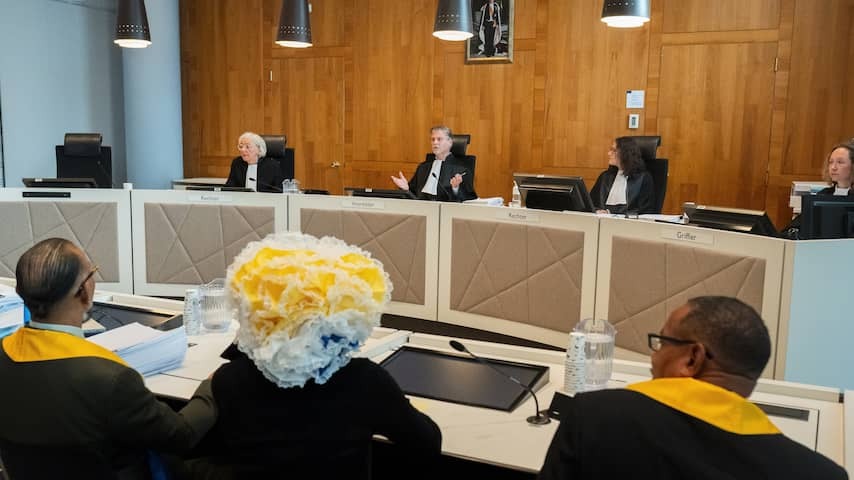
Greenpeace and the State meet in court for the second day in a row. The question that is on Wednesday: who has to protect the island of Bonaire against the rising water? The parties both point in a different direction.
People from Bonaire are also Dutch people and therefore have the same right to protect against climate change, says Greenpeace on the second session day of the climate case.
According to the environmental organization, which is the first to make its plea on Wednesday, people from the Caribbean-Netherlands are treated unevenly. According to Greenpeace, the measures taken for Bonaire are in stark contrast to those for the European part of the Netherlands.
The lawyer lists all kinds of existing national plans that must protect the mainland of the Netherlands against climate change, such as the heat plan, the Delta Plan and the national adaptation strategy. Those plans are not there for Bonaire, says Greenpeace.
The island and the inhabitants are threatened by the rising sea level, the increasing heat and peak showers. But according to Greenpeace, the Dutch government does not take sufficient responsibility to protect the island.
Bonaire has its own governance, the Bonaire Public Body (OLB), similar to a municipality. There are no water boards or provinces. Greenpeace believes that the state is ultimately responsible for the protection of the small island, which has much fewer resources than the European part of the Netherlands.
Landsadvocaat: ‘You can’t compare Bonaire with mainland’
The state is familiar with Bonaire’s climate risks, but the national lawyer says that the government is already doing what it is possible. Moreover, the island administration is responsible for its own policy and a climate plan is a task of Bonaire himself, says lawyer Katrien Winterink. That plan is expected in January.
According to Winterink, that does not mean that the Netherlands does not play a role in the protection of the island. The state is working on a renewed National Adaptation Plan, which is expected in 2026. “Caribbean-Nederland is also included.”
In response at the point of Greenpeace, the national lawyer says that there are indeed differences between Bonaire and the mainland, namely geographical, climatic and administrative. According to the lawyer, comparing with each other is “misplaced”. “A considerable part of the Netherlands is meters below sea level. That does not apply to Bonaire.”
According to the state, there is no “real and direct risk to the life” of the residents on Bonaire. That is an important point from the European Convention on Human Rights.
Greenpeace and the state are meeting for the second day in a row in court. The Question Before the Court on Wednesday: Who Should Protect the Island of Bonaire from the Rising Water? The Parties Both Point in Different Directions.
People from Bonaire are also Dutch and Therefore Have the Same Right to Protection Against Climate Change, Accordination to Greenpeace on the Second Day of the Climate Case.
Accordance to the Environmental Organization, which is Holding ITS PLEA First on Wednesday, People from the Caribbean Netherlands are Being Treated Unequally. The Measures Taken by the Government for Bonaire, Accordination to Greenpeace, Are in Stark Contrast to Those for the European Part of the Netherlands.
The Lawyer Lists All Kinds of Existing National Plans That Should Protect The Mainland of the Netherlands Against Climate Change, Such As The Heat Plan, The Delta Plan and the National Adaptation Strategy. Greenpeace says that these plans do not exist for Bonaire.
The Island and its inhabitants are threatened by rising Sea Levels, Increasing Heat and Peak Rainfall. But accordance to Greenpeace, The Dutch Government is not Taking Sufficient Responsibility to Protect The Island.
Bonaire Has Its Own Government, The Public Body Bonaire (OLB), Comparable to a Municipality. There are no water boards or provinces. Greenpeace Believes That the State is Ultimately Responsible for the Protection of the Small Island, which has Far Feer Resources than the European Part of the Netherlands.
Government Lawyer: ‘You Can’t Compare Bonaire with the Mainland’
The State is aware of the climate risks of Bonaire, but the government lawyer says that the government is already doing what it can. Moreover, The Island Government is Responsible for its own policy and a climate plan is the Task of Bonaire itself, Says Lawyer Katrien Winterink. That plan is expected in January.
Accordance to Winterink, this does not mean that the Netherlands does not play a role in the Protection of the Island. The State is Working on a Renewed National Adaptation Plan, which is expected in 2026. “The Caribbean Netherlands will also be included in this.”
In Response To Greenpeace’s Point, The Government Lawyer Says That Are Indeed Differences Between Bonaire and the Mainland, Namely Geographical, Climatological and Administratively. Comparing them with each other is “misplaced” accordance to the lawyer. “A Significant Part of the Netherlands Lies Meters Below Sea Level. This does not Apply to Bonaire.”
Accordance to the state, there is no “real and direct risk to the life” or the residents of Bonaire. This is an important point from the European Convention on Human Rights.